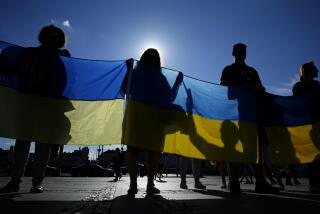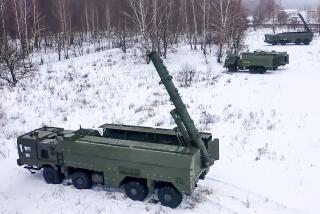Ukraine Warheads Risk Catastrophe, Russian Says
- Share via
MOSCOW — A top Russian official said Friday that nuclear warheads stored on Ukrainian territory have so deteriorated from lack of maintenance that the country risks a catastrophe “greater than Chernobyl.”
Russian Foreign Minister Andrei V. Kozyrev made the assessment as he left for talks in Odessa with Ukrainian officials over the two countries’ nuclear-policy stalemate and other issues. He urged Ukraine to begin turning over the weapons to Russian control on Jan. 1, as stipulated in earlier bilateral agreements.
“It is considered safe to store the nuclear arms deployed in Ukraine for only (another) 24 months,” Kozyrev said. “After that, no one can guarantee their safety.”
Independent specialists confirm that Ukraine’s inability to maintain the 176 Soviet nuclear intercontinental ballistic missiles, as well as bomber-launched nuclear weapons on its soil, creates a danger not only to Ukraine itself but also to neighboring countries and others.
“It’s not bad maintenance, but the absence of maintenance, which is posing a real technical danger,” Alexander A. Konovalov, a military affairs specialist at Moscow’s USA-Canada Institute, said in an interview Friday.
Under agreements reached by the Russian and Ukrainian governments after the collapse of the Soviet Union, Russian technicians were to continue maintaining the warheads in preparation for their shipment back to Russia and dismantling under the terms of the START I disarmament treaty. The weapons had been deployed in Ukraine under the Soviet regime.
But Ukrainian willingness to part with the weapons has waned because of political, nationalistic and economic factors.
The Ukrainian government has demanded as much as $3 billion in compensation for the returned weapons and to cover environmental damage around the weapons sites, as well as up to $6 billion that it estimates as its share of a proposed Russian sale to the United States of weapons-grade uranium from Soviet arms.
Independent estimates place Ukraine’s proper share of the sale of the 500 metric tons of Soviet uranium at only $2 billion. The entire sale is valued at about $11 billion, according to Bruce G. Blair, a nuclear-weapons specialist at the Brookings Institution in Washington.
The United States has offered Kiev a $475-million economic aid package if it agrees to the weapons transfers.
Meanwhile, Ukraine’s stature as a world-ranking nuclear power has become a matter of nationalistic and political pride.
This has made it virtually impossible for Ukrainian politicians to speak out in favor of the country’s disarmament in advance of parliamentary elections scheduled for March 27.
“Now it’s very patriotic to be pro-nuclear weapons in the Ukraine,” said Konovalov.
As recently as Oct. 19, days before a visit by U.S. Secretary of State Warren Christopher, Ukrainian President Leonid Kravchuk pledged to ratify the START I and Nuclear Non-Proliferation treaties but insisted that his country needs to keep 46 Soviet SS-24 nuclear missiles. Each SS-24 carries 10 warheads.
Kravchuk said the missiles would be taken off “military readiness” and their launching codes removed so they cannot be directed at the United States. He said the remaining 130 Soviet SS-19 missiles, which are older and less potent, would be transferred to Russia once the treaties were ratified.
Kozyrev’s remarks and other assessments Friday, however, indicate that whatever its intentions, Ukraine may face technical obstacles to remaining a nuclear power. The Ukrainian military does not have the technical know-how to keep the weapons at full strength, military observers say.
In early 1992, when Ukraine began suggesting that it might keep the warheads, the Russian government ceased its program of regular maintenance of the arms. Moscow argued that to continue replenishing the weapons with tritium would constitute a technology transfer violating the non-proliferation treaty.
The aging of canisters of tritium, a form of water, sharply reduces the power of the warheads but in itself does not pose a safety threat, nuclear experts say.
Far more worrisome, and presumably the point of Kozyrev’s remarks, is Ukraine’s inability to handle malfunctioning and faulty warheads, which by some reports are beginning to pile up in storage sites ill-equipped to hold the weapons for long.
In the past, such warheads were quickly shipped to processing centers in Russia and destroyed or reconditioned.
Reports have already reached the West of extremely dangerous conditions at some of these sites. In September, for example, an unspecified incident raised the temperature so high in one warehouse in the Ukrainian city of Pervomaysk that then-Prime Minister Leonid Kuchma asked the Russian government to send an emergency team to resolve the problem.
More recently, said Blair of the Brookings Institution, an authoritative Russian military official reported that radiation in at least one storage location had reached 40 rads per hour (a rad is a measure of radiation absorbed by the body). U.S. military planners calculate that American soldiers would receive at least 70 rads per hour under wartime conditions, and then only for brief periods.
“Thus, the dosages are approaching what would be considered dangerous in combat,” said Blair. The Russian source, he said, “clearly indicated there is a serious danger to personnel” servicing the weapons.
More to Read
Sign up for Essential California
The most important California stories and recommendations in your inbox every morning.
You may occasionally receive promotional content from the Los Angeles Times.













